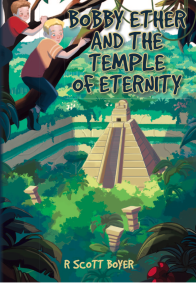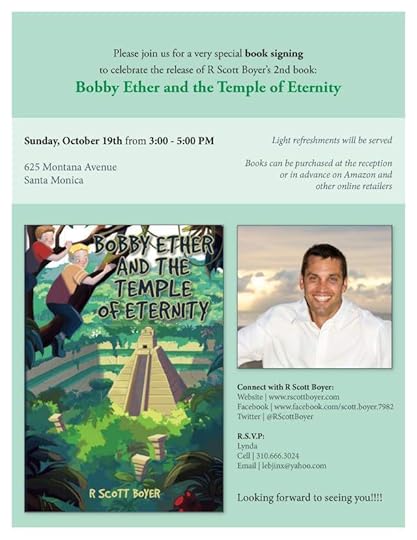R. Scott Boyer's Blog, page 13
January 26, 2015
The Easiest Writing Tip Ever
Following is an article with a surprisingly good writing tip. As the author indicates, it’s a very simple, and yet I never really thought it before reading her post. Still, it appears to makes a lot of sense. Check out her advice and decide for yourself.
The Easiest Writing Tip Ever
Rainy Kaye, January 26, 2015
 This writing tip will take about two minutes of your time.
This writing tip will take about two minutes of your time.Ready?
See how I have to pad this post with a vain attempt at anticipation, just because this tip is so easy?
Write your sentences in chronological order.
Wait, that’s it?
No, I don’t mean write sentences in order–though that’s a good idea too. I mean, in a sentence with two related events, write those events in order of occurence.
Example:
She screamed after someone knocked on the door.
Instead use:
Someone knocked on the door, and she screamed.
Example:
She blushed when he smiled at her.
Instead use:
He smiled at her, and she blushed.
Example:
She kicked the alien after it stuck its tongue out at her.
Instead use:
The alien stuck its tongue out at her. She kicked the closest of its eight shins.
Why?
Readers tend to visualize scenes in their head as they go along. While there’s nothing grammatically wrong with writing a sentence out of order, it causes a subtle, yet annoying, thing to happen. The reader briefly rewinds that moment and plays it out in the order it happened. These few seconds have jarred the reader from the story.
Like all writing tips, there are exceptions to the “rule”. However, unless you have a justification for confusing the order, try implementing this concept and see what happens. It is especially useful when handling complex or fast paced scenes.
What’s the easiest writing tip that you’ve ever received?
About the Author:
Rainy Kaye is an aspiring overlord. In the mean time, she runs Book and Blog Services, blogs at Rainy of The Dark, and is preparing to debut an epic paranormal series all from her lair somewhere in Phoenix, Arizona. When not planning world domination, Rainy can be found appeasing her inner geek or traveling to strange parts of the world. She is fueled by coffee, encouraged by chocolate, and lives in fear of the household felines plotting her demise. She’s married to a man who excels at humoring her.


January 20, 2015
R.E.W.R.I.T.E.R.
After taking time off to enjoy the holidays and then struggling with the flu for nearly two weeks, I am happy to report that I am finally back at it.
For those of you interested, I am currently working on editing book three in the Bobby Ether series, while simultaneously sketching ideas for book four. At the same time, I have begun work on a new MG/YA series that I hope to write. So far, I have just the general outline and some characters banging around in my head, but I am thrilled at the prospect of a new series and eager to see where it leads.
In the mean time, I thought I would share with you something I jotted down a while ago.
I’m not normally one for acronyms, but I thought it would be fun to create one based on one of my favorite expressions: “writing is rewriting.” Thus, I decided to play with the word ‘rewrite,’ but with my own special twist:
R ecognize good writing (mainly by reading great writers)
E nvision and explore your story — you have to live it in order to write it.
W rite it! This may seem obvious, but for many people, actually writing their ideas down is the hardest part. Don’t shirk, do the work!
R ewrite it over and over again. It doesn’t have to be perfect the first time. Keep honing, keep refining, and remember: writing is rewriting.
I magine the possibilities — let your creativity have free reign. Remember, you don’t have to use everything you write, and nothing has to be perfect.
T ry and test changes. Don’t be afraid to experiment. Again, just because you write it, doesn’t mean you have to use it. See where new ideas lead, then decide.
E valuate. Decide what works and what doesn’t.
R ewrite (again and again)
Yes, I snuck in an extra ‘R’ at the end by taking ‘rewrite’ and making it ‘rewriter.’ Why? Because rewriting is that important. Be creative but also be critical. Be your own harshest critic, and also a hard worker, and you should never be disappointed with the results.


December 16, 2014
Starting Out As A Writer: 5 Things You Should Know
First of all, I want to wish everyone a belated happy Thanksgiving and a very merry upcoming Chanukah, Christmas, and New Years. I realize I haven’t posted anything in quite a while. Like many people, the holidays are a busy time for me and a season during which I change my routine. For the past three months, I’ve been doing volunteer work to help run the Veterans’ Holiday Celebration. I also helped out at the United in Harmony Holiday Party this past weekend—an event that was incredibly fun, as always!
Because of all these events, I’ve been taking a break from writing and blogging, but still following other authors and blogs that I find interesting. Below is one I found this morning from Amy Neftzger which I think is worth sharing. I’ll get back to posting some of my own after the new year.
Amy NeftzgerDecember 16, 2014
 Becoming an author is a long road to walk, and most people have no idea how long it takes to become successful or what they need to do when traveling this road. There are a lot of different ways to get to the end of it, but here are a few suggestions I have to help you along on this journey.
Becoming an author is a long road to walk, and most people have no idea how long it takes to become successful or what they need to do when traveling this road. There are a lot of different ways to get to the end of it, but here are a few suggestions I have to help you along on this journey.1. Success is not immediate
Many people think that publishing a book is like winning the lottery: you just put the book up for sale and then watch the royalties roll in. The truth is that simply putting your work out there will not make it sell. Readers have too many choices, and when they want a new book they tend to stick with what they know: authors they’ve already read. It takes quite a bit of time to build a following, so patience is the name of the game here. This is true whether you’re self or traditionally published.
2. In order to do it well, you will need help.
Don’t assume that you can write, edit, design layout, format, create cover artwork, and market your book all on your own. If you’re with a traditional publisher they will help with most of these things. If you’re self-published, you’ll need to find a way to get all these things done. You may be multi-talented but you’re still only one person and you may even have another job that currently pays your bills. So there’s the time factor to consider: If you do everything yourself then you’re spending a lot of time doing things other than writing. Aside from the time, when you do everything yourself your work tends to lack the balance that other people can add. Your finances may be limited, so figure out what you’re better at and where you’re weaker and seek affordable help for your weaker areas.
3. The market is currently flooded.
There are a lot of books out there and the number is growing, so readers have a lot of choices. What this means is that your book needs to be the best it can possibly be, because a less polished work simply won’t get any traction in a flooded market. This means that you may want to consider using beta readers to get feedback, and if you’re self-published you should definitely hire an editor and maybe even a proofreader.
4. Reader experience is everything.
People read books for the experience it provides. Your book should be designed to provide it and avoid anything that detracts from it.Things that pull away from the experience are glitches in plot development, spelling or layout errors, and errors in logic. maintaining a logical and believable flow to the plot will enhance reader experience, so use a good outline and be sure that the characters and situations are believable (even in fantasy).
5. It’s worth the effort
If you love to write and it’s in your blood, then you’ll find that all the work you put into producing your book is worth your time. The key is to keep working and improving your craft and to grow as a writer.
About the Author:
Amy Neftzger is the author of fiction books for both adults and children. She has also been published in business and academic journals, as well as literary publications. A few of her favorite things include traveling, books, movies, art, the Oxford comma, and gargoyles.

November 14, 2014
Bobby Ether And The Temple Of Eternity
This morning, IndieReader released their review for my second book, Bobby Ether and the Temple of Eternity.
 Also noteworthy today is the news that Hachette and Amazon have finally settled their dispute over book pricing via the giant online retailer. Details on that development can be found here.
Also noteworthy today is the news that Hachette and Amazon have finally settled their dispute over book pricing via the giant online retailer. Details on that development can be found here.
IndieReader for Bobby Ether and the Temple of Eternity:
IR Verdict: BOBBY ETHER AND THE TEMPLE OF ETERNITY is a fun, if superficial, read. It provides a quick look into the cultures of Guatemala, and takes readers on a short adventure that is wrapped up with minimal loose ends.
Book Reviews, eBooks, Fantasy, Fiction, General Fiction, Young Adult • Nov 14, 2014
Unknown-1
“Bobby is a typical boy and the cast of characters that surround him are likewise easy to understand. “
BOBBY ETHER AND THE TEMPLE OF ETERNITY continues the adventures of Bobby Ether, a boy with incredible talents, a family with secrets, and a penchant for landing in trouble. This episode finds him in Guatemala, searching for his friends and continuing to fight against the evil Core.
Bobby Ether might have just escaped the dangerous Academy, but he’s not enjoying his relaxation time. His past adventures have changed him and he’s no longer able to just chill out with his parents, especially when he knows that some of his friends didn’t get so lucky. When Chief, the wise teacher and Jinx, Bobby’s younger cousin, offer to train him, Bobby jumps at the chance. Bobby, Jinx, Chief and all their friends have deep, mystical talents that make them very different from normal, and exactly the type of people that the Core (the book’s villainous group) are looking for. When Chief gets a lead on where Bobby’s friends from the Academy might be, the trio takes off for Guatemala, which coincidentally is where Bobby’s grandfather is searching for his extremely powerful wife. In short order Jinx and Bobby find themselves back in the grips of the very people they were so happy to escape, but this time, they might have a bit of an advantage.
Boyer’s story, while perhaps lacking in deeper morals and meaning, is a fun, light read. Bobby is a typical boy and the cast of characters that surround him are likewise easy to understand. There is not any strong character development or growth, but at the same time the story does not necessarily require any to get from point A to point B. The trouble Bobby and his friends land in (fighting giants, rescuing students, climbing cliffs, etcetera) are all engaging to read about, though admittedly there is no suspense built up. Boyer’s characters never seem to realize how much danger they’re really in, and because they’re not especially afraid, the reader isn’t either. Whether this was a choice or just a happenstance is not clear.
What is arguably the best part about BOBBY ETHER AND THE TEMPLE OF ETERNITY also has the least screen-time. All of the students introduced appear to have unique gifts. It is heavily implied that Bobby’s personal arsenal goes above and beyond the normal abilities for these gifted youngsters, but this does not appear to be developed. It is possible that Boyer is waiting to bring this detail into later books, but an increased focus on why Bobby is special definitely would have made BOBBY ETHER AND THE TEMPLE OF ETERNITY more engaging.
BOBBY ETHER AND THE TEMPLE OF ETERNITY is a fun, if superficial, read. It provides a quick look into the cultures of Guatemala, and takes readers on a short adventure that is wrapped up with minimal loose ends.
~IndieReader.
- See more at: http://indiereader.com/2014/11/bobby-ether-temple-eternity/#sthash.X0dZejTx.dpuf


November 7, 2014
Foreword Clarion Review
The first professional review for my second book, Bobby Ether and the Temple of Eternity, is now in from Clarion Foreword. While it appears that the reviewer wasn’t thrilled with the illustrated cover, the review of the book itself is quite positive. Here is what she had to say:
Warning—this review contains mild spoilers about the end of book one.
Bobby Ether and the Temple of Eternity
 Reviewed by Lynn Evarts
Reviewed by Lynn Evarts
November 5, 2014
Friendship, loyalty, and fantasy adventure highlight this second book in a series.
In R. Scott Boyer’s Bobby Ether and the Temple of Eternity, readers discover what happened after the cliffhanger ending in book one of this series, Bobby Ether and the Academy. Boyer clears up some of the mysteries and sends Bobby, Jinx, and Chief off on a new adventure that centers on the fabled Fountain of Youth.
Fourteen-year-old Bobby Ether has special skills: he can tap into ethereal energies and connect living things to one another. Along with that, he is fearless and adventuresome, never afraid to tackle a problem with his cousin Jinx by his side. Because of the uncertainty at the ending of book one, Bobby’s first and foremost task is to learn what happened to his friends Trevor, Lily, and Jacob. Along with that task, Bobby ventures into the jungles of Guatemala to explore an ancient Mayan pyramid that may be under the control of agents of the Core.
This book is considered a young adult science fiction/fantasy book that is appropriate for middle grade students and up. It suffers from an identity crisis, however. The cover will not attract most middle grade readers because the artwork is more juvenile than middle grade, and the characters pictured look younger than the target audience, and much younger than Bobby’s given age in the story. Conversely, the text inside is small and there is little white space on the page, making the book seem like it is targeted to an older audience.
The story itself is interesting. Readers are introduced to new places and cultures, and the elements of science and fantasy are well done. The details about the places the characters explore are interesting and very specific. Yet some of the word choices will cause middle grade readers to struggle. “The lone runway at Chiquimula Airport in Chiquimula, Guatemala, consisted of a dirt strip with patches of grass trimmed daily to keep the ubiquitous vegetation from reclaiming it.” This, and other sentences in the book, read more like a college textbook than a book for students in grades six through eight.
A strength of this series is the friendship and loyalty that Bobby and his friends exhibit. With middle school as a time of shifting friendships and cliques, this book does a nice job reinforcing the concepts of sticking together and persevering, and Bobby and Jinx are rewarded for their efforts. Middle grade readers interested in green-themed reading and more of a non-Christian spirituality may be good candidates for this title.


November 5, 2014
Who Pays for Book Reviews?
Interesting commentary on the book review system.
 Originally posted on US Review of Books:
Originally posted on US Review of Books:
The short answer is everyone, although it might not be evident at first. National publishing trade magazines present the illusion that they are fair and balanced—a familiar phrase—in their review coverage, but given a closer look, these publications thrive on the sales of expensive advertising space, including their front and back covers. Other national trades don’t even hide the fact that they charge hundreds of dollars per review. You’ll notice that very few small publishers are mentioned in their pages. The presses that cannot afford ad space and review fees coincidentally go unmentioned, and all independent presses (i.e. micro presses and self-publishers) are typically barred from book review consideration.
Consider that advertising fees are built into the budgets of large press books, and when you purchase one, you are in effect paying for their media coverage somewhere along the line. There is simply no justification for highlighting or featuring the…
View original 469 more words


November 3, 2014
Editing Blues
More and more, I am coming across interesting articles from other authors about the creative process. Here is one about editing.
I really like the comparison Madison draws between cleaning your house and editing your manuscript—you may not want to do it, but it needs to be done! As for her question about self-editing or hiring an editor, the answer for me is ‘both.’
I firmly believe that a good writer takes the time to revise their manuscript until they’re satisfied with what they see. That said, a professional editor will undoubtedly find additional issues that need attention.
In this age of e-publishing, with so many people skimping on editing, its the works of quality that make the biggest impression.
- Scott Boyer
Got The Editing Blues? How To Edit Your Book In 5 Easy Steps
Marla Madison, November 3, 2014
 You’ve written “The End” either on the page or in your mind. Are you feeling a euphoric sense of relief and accomplishment? Or a sinking feeling of despair because the worst is yet to come—the dreaded edits! If the second describes your feelings about reaching the last page, then you have a lot of company, myself included.I’m having people over to my house tomorrow night to play bridge. No need to worry about things they’d never see, right? It occurred to me that the tasks of editing my novel and cleaning my house have a lot in common, a rather discouraging realization since I hate cleaning.Never being one to avoid doing things the easy way, I plotted just what had to be done. I decided the best way to move forward with either task was to have a plan. Just as I wouldn’t vacuum a room before I dust, I’d have to tackle editing in an organized manner in order to save myself from endless do-overs.
You’ve written “The End” either on the page or in your mind. Are you feeling a euphoric sense of relief and accomplishment? Or a sinking feeling of despair because the worst is yet to come—the dreaded edits! If the second describes your feelings about reaching the last page, then you have a lot of company, myself included.I’m having people over to my house tomorrow night to play bridge. No need to worry about things they’d never see, right? It occurred to me that the tasks of editing my novel and cleaning my house have a lot in common, a rather discouraging realization since I hate cleaning.Never being one to avoid doing things the easy way, I plotted just what had to be done. I decided the best way to move forward with either task was to have a plan. Just as I wouldn’t vacuum a room before I dust, I’d have to tackle editing in an organized manner in order to save myself from endless do-overs.Here is what I came up with:
• The absolute first thing. Have the right tools at your fingertips: Dictionary, thesaurus, red pen, notebook, and any edit notes you made while writing your book.
• Get rid of the clutter! Go through your manuscript and note any glaring problems. Fix spelling, grammar, typos, and conflicting details or (my personal downfall) consistency in character’s names, which also includes spelling their names the same way every time they’re mentioned. During this read through, keep lists of anything in your story line that needs work. If you haven’t already done so, make detailed character lists.
• Decide what has to be done – Separate the lists you’ve made into categories. Now read through your book, preferably out loud, for flow, plot, interest, etc. Are the things you noted necessary changes?
• Clean house – Make critical revisions based on your notes and your read through. Get rid of unnecessary wordage even if it’s painful.
• Save the heavy cleaning for after the party – Only when you’re satisfied that your work flows, and grammar, spelling, and typos are corrected, is your manuscript ready to send to your professional editor and beta readers. If you’ve done your housekeeping well, your final revisions and clean-up will be as smooth as a bowl of chocolate ice cream.
This list is a simplistic approach, designed to help you get started on what feels like a monumental task. If you need a more detailed advisory, or if this is your first book, I’d recommend picking up a book on editing. One I’ve used is Self-Editing for Fiction Writers, by Renni Browne and David King.
It’s vital to invest in a professional editor and proofreader if at all possible. If it isn’t, make sure you have a list of beta readers who will give you detailed, constructive feedback. I’d also advise joining a critique group of experienced authors and also finding someone to read your book out loud to you. Or record your own read through and play it back.
You’ve put a lot of precious time and effort into your book—don’t let it down by publishing a flawed product. Remember, the competition is fierce and readers demanding.
What’s your take? Will you self-edit or hire an editor?
About the Author:
Marla Madison is a retired Federal Mediator, now working as an Arbitrator for the state of Iowa and the Federal Mediation Service. She’s Not There is her debut suspense novel, and Relative Malice, her second. Marla is working on a third suspense story, that while not a sequel to She’s Not There, does have some of the same characters.
Marla lives on Prairie Lake in Northwestern Wisconsin with her significant other, Terry, a beloved shelter-dog, Skygge, and Poncho, an opinionated feline from the same shelter.
Also an avid reader of suspense, some of her favorite authors are Tana French, Lisa Gardner, Jeffrey Deaver, Jonathan Kellerman, James Patterson, Tess Gerritson, and Tami Hoag.
When not reading or writing, Marla enjoys playing duplicate bridge, golfing, and going on long walks with her dog.
You can catch her on her website www.marlamadison.blogspot.com and Twitter.


October 31, 2014
7 Point-of-View Basics Every Writer Should Know
Happy Halloween everyone! I’ve been so busy completing the first draft of my third book, Bobby Ether and the Great Sphinx, that I haven’t had time to post much. Still, I love interesting articles about writing and the creative process. Thus, I want to share this one by Jody Hedlund. I hope you enjoy it.
7 Point-of-View Basics Every Writer Should Know
Jody Hedlund, October 30, 2014
 In writing lingo we refer to point-of-view (POV) as the character through whom we tell the story. We get into the head of a particular character and see the story through her eyes. Sometimes we have one POV through the whole story. Other times we have multiple POVs.Recently while reading a book, I became confused with some of the point of view changes. It was a really good story in many ways, and the author has had a long term writing career. So I was surprised to have to slog my way through several spots of hopping from one head to the next.As I thought about the POV issues, I realized that during the last ten years, POV “rules” have grown more firm. Editors, agents, and readers want clear, concise, easy-to-read stories. Head-hopping can brand us as an amateur. That means we have to understand some of the basics that go into having clear POVs.1. Strategically pick the number of POV characters. We can’t get into the head of everycharacter in our books. Nor should we randomly or haphazardly pick POV characters. We should usually try to narrow down those characters we want our readers to care most about—usually the main characters (hero and heroine). Sometimes, I’ve seen writers tell snippets of the plot from the POV of the antagonist to add tension.
In writing lingo we refer to point-of-view (POV) as the character through whom we tell the story. We get into the head of a particular character and see the story through her eyes. Sometimes we have one POV through the whole story. Other times we have multiple POVs.Recently while reading a book, I became confused with some of the point of view changes. It was a really good story in many ways, and the author has had a long term writing career. So I was surprised to have to slog my way through several spots of hopping from one head to the next.As I thought about the POV issues, I realized that during the last ten years, POV “rules” have grown more firm. Editors, agents, and readers want clear, concise, easy-to-read stories. Head-hopping can brand us as an amateur. That means we have to understand some of the basics that go into having clear POVs.1. Strategically pick the number of POV characters. We can’t get into the head of everycharacter in our books. Nor should we randomly or haphazardly pick POV characters. We should usually try to narrow down those characters we want our readers to care most about—usually the main characters (hero and heroine). Sometimes, I’ve seen writers tell snippets of the plot from the POV of the antagonist to add tension.If we add too many POVs, we risk confusing our readers. We also risk developing shallower characters since we’ll have less time in each person’s head, giving our readers less of an opportunity to get to know and thus love the characters.
2. Introduce all the POV characters within the first few chapters. We won’t want to all-of-a-sudden halfway through the book throw in a new POV from one of our characters that hasn’t had a voice yet. It’s best if we introduce all of our POV characters fairly early in the story.
3. Delineate POV changes by a line break or chapter break. In other words, we need to make it very clear when we’re switching to someone else’s POV. Hopping heads halfway through a scene just doesn’t work anymore (if it ever did).
If I want to change POV, I finish the scene first. Before I change POV, I move to a new stage, new setting, and new plot point. Of course, this means before starting each scene I have to determine which POV character will help accomplish the goals for the scene most adequately. And if I need readers to “get in the head” of another POV character during that scene, then I have to SHOW the reactions (or wait to recap their thoughts when their POV comes along in a later scene).
4. After a POV break, clarify the new POV within the first sentence or two. I usually try to use the new POV character’s name in the first sentence. And if not, then I weave it in the second sentence so that my readers are clear right from the start of the scene whose head they’re in. If switching among first person POV, I often write out the character’s name/title at the start of the scene or chapter.
5. Bring in each POV character regularly. I don’t perfectly alternate scenes between my hero and heroine. Sometimes I may need a couple of scenes in my heroine’s POV or vice versa. But I try not to go too long in one person’s head. For those writing with three or more POVs, the juggling can get even more complicated. But we have to remember to keep all the balls in the air.
6. Beware of making POV scenes too short. Story pacing will play a role in how long our scenes are. When we find ourselves changing POV every few paragraphs or multiple times per scene, then we may begin to annoy our readers. If we don’t have a long enough scene, then perhaps we don’t have enough goals and need to consider how we can combine the scene with another.
7. Once in a POV, stick with it carefully. When we get into one of our character’s heads, we need to do the best we can to see, hear, taste, touch, smell, and think about everything the way that particular character would. The more we can stay deeply inside our POV character, the more alive that character will become to our readers.
Remember, we can’t have our characters noticing things about themselves that they wouldn’t normally see. If in doubt, use the mirror test: Am I describing something about my character she would see of herself (i.e. the protruding blue veins in her hand)? Or would she need a mirror to notice it (i.e. the color of her own eyes)?
If she needs a mirror, then she shouldn’t be thinking it about herself (unless she really is looking into a mirror, which incidentally has become a clichéd way of having characters describe themselves).
What other POV tips do you have? What’s been your biggest struggle in handling POV changes?
About the Author:
Jody Hedlund is an award-winning and bestselling author of inspirational historical romances.
As a busy mama-writer, she has the wonderful privilege of teaching her crew of 5 children at home. In between grading math papers and giving spelling tests, she occasionally does a load of laundry and washes dishes. When she’s not busy being a mama, you can find her in front of her laptop working on another of her page-turning stories.
You can catch her on her website www.jodyhedlund.com where she gives great advice for writers and Twitter where she gushes about reading, chocolate, cats, and coffee.
This article originally appeared on www.JodyHedlund.blogspot.com


October 10, 2014
Book Release Celebration
In celebration of the release of my second book, a few family members and friends are throwing me a party! It’s also going to be a book signing and speaking, so anyone who is interested is welcome to attend. I love to meet my fans! Here are the details:


September 29, 2014
Why Talent Isn’t Enough
I just came across this fantastic post from Jody Hedlund and found it worth sharing. I couldn’t agree more that rejection serves as a much needed reality check for beginning writers. It most certainly helped motivate me and continues to push me to become the best writer I can be. I hope you find her advice helpful. Enjoy!
Why Talent Isn’t Enough
Jody Hedlund September 29, 2014
How  important is talent to a writer? Is talent required in order to become successful? Is talent necessary to rise above the competition?
important is talent to a writer? Is talent required in order to become successful? Is talent necessary to rise above the competition?
I’d be remiss to throw out talent altogether and say that it doesn’t matter in the least. The truth is a bit of natural talent can probably help to a degree. Some people are born with wild imaginations. Some have the ability to embellish a story. Others have a smooth way of stringing words together. And all of that can certainly give a writer an advantage.
Sometimes when people ask me where I get my story ideas or how I come up with a great plot twist, I stumble to find an answer. There are just some writing nuances that I can’t explain, that just flow, that seem to be hard-wired into my makeup. Dare I say that I have some giftedness without sounding conceited?
However, even when writers are born with certain proclivities, usually talent alone isn’t enough to propel a writer to the NYT best-seller list. And yet, there’s a widely-held misconception that those who make it big or land multiple book deals simply have more talent than the average writer.
In fact, I think it’s all too common for many beginners to have an elevated perception of their writing skill. When I was just beginning, I know I did. I thought my first couple of manuscripts were pretty spectacular. I figured publishers would be knocking down my door to buy my books.
Like many newbies, I thought my talent was enough to make my books special and different from the masses of others out there, that perhaps my books had an almost magical quality that could propel them forward ahead of others.
Fortunately, rejection was the humbling reality check. Rejection from publishers and agents helped me realize I wasn’t God’s gift to the literary world and that I still had a lot to learn before my material was ready for readers. It wasn’t until my fifth book that I finally reached a point where my writing was good enough to catch the attention of an editor. Even then that particular book was rejected. But the interest helped me see that my writing skill was improving.
Unfortunately today, with the ease of self-publishing, many newer writers have lost the humbling reality check that was once a part of the process. Too many beginners with an elevated perception of writing talent (like I had!) toss aside the cautions about rushing to publish the first book or two they’ve ever written. They overlook advice about getting professional editing. Sometimes they ignore writing advice altogether.
It’s all too easy nowadays with social media to see what everyone else is doing, to hear the success stories and to think that “easy” is the norm and that talent alone is enough.
But what we don’t see is just how hard each of those successful writers had to work to reach the point where their writing was finally ready for readers to enjoy. We don’t see the years and years of writing with no return. We don’t see the hours of learning basic writing mechanics. We don’t see the multiple rejections. We don’t see the money spent on editing or critiques.
Yes, having some talent can give a writer a slight edge. But talent alone is not enough to become a good writer. Each step forward I’ve taken in my writing career has been hard-earned. I’ve had to scrape, claw, and fight for every inch of success. Nothing has come easy. Even after six published books and eight more coming down the publication pipeline, I continue to sweat and fight hard for every small victory.
My advice for beginners? Don’t assume your talent is enough. Talk to successful authors and get a behind-the-scenes look at the amount of work they’ve put in. Look for ways to get “reality checks” to find out how you’re really doing. Be patient with yourself. And most of all keep learning and writing because eventually with enough hard work, your stories will be ready for readers.
So what about you? How important do you think talent is in reaching writing success?
About the Author:
Jody Hedlund is an award-winning and bestselling author of inspirational historical romances.
As a busy mama-writer, she has the wonderful privilege of teaching her crew of 5 children at home. In between grading math papers and giving spelling tests, she occasionally does a load of laundry and washes dishes. When she’s not busy being a mama, you can find her in front of her laptop working on another of her page-turning stories.
You can catch her on her website www.jodyhedlund.com where she gives great advice for writers and Twitter where she gushes about reading, chocolate, cats, and coffee.






